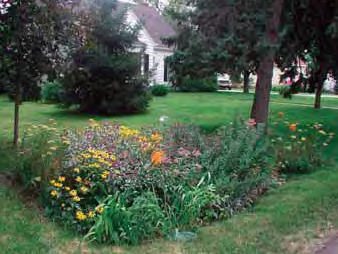
Rain Gardens
Stormwater
A rain garden is a small residential depression planted with native wetland and prairie vegetation (rather than a turfgrass lawn) where sheet flow runoff collects and infiltrates. Rain gardens function similar to larger-scale bioretention areas. Typical sites for rain gardens include residential yards and community common areas.
Water plants regularly until they become established. Afterwards, they should need little to no additional watering. Weed and prune as you would any garden. Do not be afraid to move plants around if you think they would do better in drier or wetter parts of the garden. Your garden may need a bit more maintenance than a lawn in the beginning, but in the long run it will be easier to care for and provide many added benefits!
Ponding depths restricted to 6 inches or less; Deep rooted perennials and trees are encouraged; The planting soil should be a mixture of sand, loam, and clay to provide water and nutrients to the plants; Native species that are tolerant of both wet and dry cycles are highly recommended; Modify soil with compost to increase permeability; Provide a drain tile system if soil permeability is a problem; Maintenance, including mowing and weeding, is typically required two times a year. Before developing a rain garden, it is essential to determine whether the soil conditions in your yard are adequate for a rain garden. Conduct an Infiltration Test to determine your soil’s suitability.
The cost of rain gardens vary and are scale dependent. On a unit basis, the cost may range from less than $2 to more than $14 per cubic foot, depending on size of the garden, vegetation used, and age of the vegetation planted. If seedling plugs are used, the cost increases. If the garden is prepared from seed, the cost is substantially less.
Provides localized stormwater control by collecting and storing water, allowing water infiltration into the soil; Improves water quality by filtering pollutants from stormwater; Easy to plan and build; Aesthetically pleasing; Flexible to incorporate existing natural features; Preserves natural/native vegetation; Protects adjacent properties.